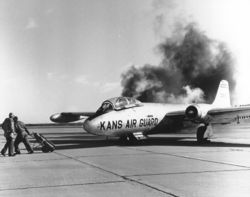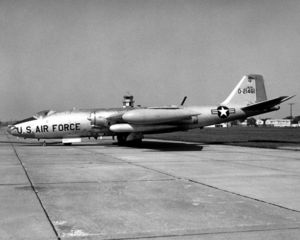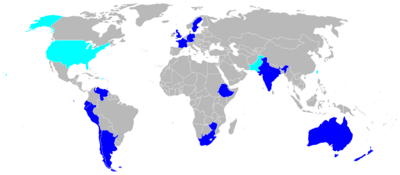PlaneSpottingWorld welcomes all new members! Please gives your ideas at the Terminal.
B-57 Canberra
| B-57 Canberra | |
|---|---|
| USAF B-57 dropping 750 lb (340 kg) bombs. | |
| Type | Bomber |
| Manufacturer | Martin |
| Designed by | Teddy Petter |
| Maiden flight | 20 July 1953 |
| Introduced | 1954 |
| Status | Retired |
| Primary users | United States Air Force Pakistani Air Force Republic of China Air Force |
| Number built | 403 |
| Unit cost | US$1.26 million (B-57B)[1] |
| Developed from | English Electric Canberra |
The Martin B-57 Canberra was a twin-engine jet bomber and reconnaissance aircraft which entered service in the 1950s. Originally based on the British English Electric Canberra, the US-built B-57 had evolved into several unique variants.
Contents
Development
At the outbreak of the Korean War in 1950, the United States Air Force found itself in dire need of an all-weather interdiction aircraft. The piston-engined Douglas A-26 Invaders were limited to daytime and fair weather operations and were in short supply. Thus, on 16 September 1950 the USAF issued a request for a jet-powered bomber with a top speed of 630 mph (1,020 km/h), ceiling of 40,000 feet (12,190 m), and range of 1,150 miles (1,850 km). Full all-weather capability and secondary reconnaissance role had to be included in the design. To expedite the process, only projects based on existing aircraft were considered. The contenders included the Martin XB-51, and the North American B-45 Tornado and AJ Savage. In an extremely rare move, foreign aircraft including the Canadian Avro Canada CF-100 Canuck and the British English Electric Canberra were also given consideration. The AJ and B-45 were quickly dismissed because their outdated designs had limited growth potential. The CF-100 was too small and lacked sufficient range. The XB-51, while very promising and much faster, had limited maneuverability, a small weapons bay, and limited range and endurance.
On 21 February 1951, a British Canberra B.2 became the first-ever jet to make a non-stop unrefuelled flight across the Atlantic Ocean, arriving in the United States for USAF evaluation. The Canberra emerged a clear winner of the 26 February flyoff against the XB-51. Since English Electric was unable to produce enough aircraft for both the RAF and the USAF, on 3 April 1951 Martin was granted the license to build Canberras, designated B-57 (Martin Model 272) in the US. To expedite production, the first B-57As were largely identical to the Canberra B.2s with the exception of more powerful Armstrong Siddeley Sapphire engines of 7,200 lbf (32 kN) of thrust, also license-built in the US as Wright J65s. In addition, canopy and fuselage windows were slightly revised, the crew was reduced from three to two, wingtip fuel tanks were added, engine nacelles were modified with additional cooling scoops, and the conventional "clamshell" bomb-bay doors were replaced with a low-drag rotating door originally designed for the XB-51.
The first production aircraft flew on 20 July 1953, and was accepted by USAF on 20 August. During the production run from 1953 to 1957, a total of 403 B-57s were built.
Operational history
The USAF Strategic Air Command had B-57 Canberras in service from 1956 through 1962[citation needed].
The B-57A was not considered combat-ready by the USAF and the aircraft were used solely for testing and development. One of the aircraft was given to the National Oceanic and Atmospheric Administration which fitted it with a new nose radome and used it to track hurricanes. The reason for such limited production was that the distinctly British B-57A was considered unfit for USAF service. Particularly contentious were the odd cockpit arrangement and the lack of guns, the British Canberra having been designed as a high-speed, high altitude bomber rather than for close air support. The definitive B-57B introduced a new tandem cockpit with a bubble canopy, the engines were now started with a pyrotechnic cartridge, the airbrakes were moved from the wings to the sides of the fuselage for increased effectiveness, the controls were now boosted, four hardpoints were fitted under the wings, and the aircraft was given gun armament in the form of 8 x 0.50 in (12.7 mm) Browning machine guns in the wings, later replaced by 4 x 20 mm M39 cannons. The first B-57B flew on 18 June 1954. The aircraft initially suffered from the same engine malfunctions as the RB-57As and several were lost in high-speed low-level operations due to a faulty tailplane actuator which caused the aircraft to dive into the ground. The USAF considered the B-57B inadequate for the night intruder role and Martin put all aircraft through an extensive avionics upgrade. Regardless, by the end of 1957 the USAF tactical squadrons were being re-equipped with supersonic F-100 Super Sabres. The complete retirement was delayed, however, by the start of the Vietnam War.
Vietnam
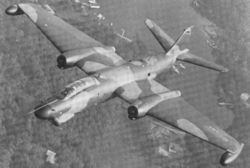
The deployment of B-57Bs from 8th and 13th Bomb Squadrons to Bien Hoa began with three aircraft lost in collisions on arrival. An additional five aircraft were destroyed with another 15 damaged by a Viet Cong mortar attack in November 1964. The first combat mission was not flown until 19 February 1965, with the first excursion into North Vietnam taking place on 2 March as part of Operation Rolling Thunder. The aircraft typically carried 9 x 500 lb (227 kg) bombs in the bomb bay and 4 x 750 lb (340 kg) bombs under the wings. In April 1965, Canberras began flying night intruder missions supported by C-123 Provider or C-130 Hercules flare ships and EF-10B Skyknight electronic warfare aircraft. On missions extending into North Vietnam, B-57Bs carried their own flares. On 16 May 1965, an armed B-57B exploded on the runway at Bien Hoa setting off a chain reaction that destroyed ten other Canberras, eleven A-1 Skyraiders, and one F-8 Crusader. Due to combat attrition, in October 1966 B-57Bs were transferred to Phan Rang where they supported operations in the Iron Triangle along with Australian Canberra B.20s. The aircraft also continued to fly night interdiction missions against the Ho Chi Minh trail. Of the 94 B-57Bs deployed to Southeast Asia, 51 were lost in combat and 7 other Canberra's were lost to other causes. Only 9 were still flying by 1969. As the result, the Canberras were withdrawn from service.
Pakistan
The Pakistan Air Force was one of the main users of the B-57 and made use of it in two wars with India. In the Second Kashmir War of 1965 B-57s flew 167 sorties, dropping over 600 tons of bombs. Three B-57s were lost in action, along with one RB-57F electronics intelligence aircraft. [1] In the Indo-Pakistani War of 1971 there was a higher attrition rate with at least 5 B-57s being put out of service by the end of the war. [2] [3] They were retired from service in the PAF in 1985.
Reconnaissance B-57s
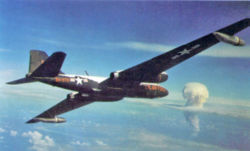
While the USAF found the B-57A lacking, the photoreconnaissance RB-57A saw some operational use. First flying in October 1953, RB-57As fully equipped the 363rd Tactical Reconnaissance Wing at Shaw Air Force Base by July 1954. The aircraft were also deployed with USAF squadrons in Germany, France, and Japan. However, operational readiness was poor and the aircraft suffered from significant production delays because of engine problems. Wright had subcontracted production of J65 engines to Buick which resulted in slow deliveries and tendency to burn oil which filled the cockpit with smoke. The problems were ameliorated when Wright took over the production in 1954. RB-57As also suffered from a high accident rate caused in part by very poor single-engine handling, which resulted in the entire fleet spending much of 1955 on the ground. By 1958, all RB-57As were replaced in active service by Douglas RB-66Bs and RF-101As. Air National Guard units extensively used RB-57As for photographic surveys of the United States and traded in their last aircraft in 1971. Two RB-57As were used by the Republic of China Air Force for reconnaissance missions over People's Republic of China. One of these was shot down by a Chinese Mikoyan-Gurevich MiG-17 on 18 February 1958. Two other RB-57As were used by the Federal Aviation Administration to plan high-altitude airways for the upcoming jet passenger aircraft.
A number of RB-57s were used by the 7499th Support Group at Wiesbaden in 'Heart Throb' reconnaissance missions over Europe. [4]
Starting in 1959, Martin began to modify retired RB-57As with electronic countermeasures (ECM) equipment in the bomb bay. Redesignated EB-57A, these aircraft were deployed with Defense Systems Evaluation Squadrons which played the role of aggressors to train the friendly air defense units in the art of electronic warfare. Subsequent bomber variants were also modified to fulfill this role.
Variants
- B-57A
- First production version; 8 built.
- B-57B
- Definitive production version, tandem cockpit, 8x 0.50 in (12.7 mm) machine guns or 4x 20 mm cannons, four underwing hardpoints; 202 built.
- B-57C
- Dual-control trainer, first flight 30 December 1954; 38 built.
- B-57E
- Target tug, first flight 16 May 1956; 68 built.
- B-57G
- B-57Bs modified as night intruders with FLIR, LLTV and laser designator in the nose, capable of using laser-guided bombs; 16 converted.
- EB-57A
- Electronic aggressor aircraft converted from RB-57As.
- EB-57B
- ECM aircraft converted from B-57Bs.
- EB-57D
- ECM aircraft converted from RB-57Ds.
- EB-57E
- Electronic aggressor aircraft converted from B-57Es.
- RB-57A
- Photoreconnaissance version with cameras installed aft of the bomb bay; 67 built.
- RB-57B
- Photo-reconnaissance aircraft converted from B-57Bs.
- RB-57D
- High-altitude reconnaissance version, J57-P-9 engines, wingspan increased to 105 feet (32.00 m), first flight 3 November 1955; 20 built.
- RB-57E
- B-57Es modified to all-weather reconnaissance aircraft, used in "Patricia Lynn" missions during the Vietnam War; 6 converted.
- RB-57F
- High-altitude reconnaissance version developed by General Dynamics, TF33-P-11A turbofan engines with provision for auxiliary J60-P-9 turbojets, first flight 23 June 1963; 21 built (3 converted from RB-57As, 4 from RB-57Ds, the rest from B-57Bs).
- WB-57F
- Weather reconnaissance version.
- RB-57Fs used for high altitude atmospheric sampling in support of nuclear weapon testing and weather research. Two WB-57F aircraft were transferred to NASA and are the only WB-57s still flying in the world today [5]. They are used for atmospheric research and for monitoring Space Shuttle takeoff and landing.
Operators
- Template:PAK: Pakistan Air Force
- Template:ROC: Republic of China Air Force
- Template:USA: United States Air Force, NASA
Specifications (B-57B)
Data from Quest for Performance[3]
General characteristics
- Crew: 2
- Length: 65 ft 6 in (20.0 m)
- Wingspan: 64 ft 0 in (19.5 m)
- Height: 14 ft 10 in (4.52 m)
- Wing area: 960 ft² (89 m²)
- Empty weight: 27,090 lb (12,285 kg)
- Loaded weight: 40,345 lb (18,300 kg)
- Max takeoff weight: 53,720 lb (24,365 kg)
- Powerplant: 2× Wright J65-W-5 turbojets, 7,220 lbf (32.1 kN) each
- * Zero-lift drag coefficient: 0.0119
- Drag area: 11.45 ft² (1.06 m²)
- Aspect ratio: 4.27
Performance
- Maximum speed: Mach 0.79 (598 mph, 960 km/h) at 2,500 ft (760 m)
- Cruise speed: 476 mph (414 knots, 765 km/h)
- Stall speed: 124 mph (108 knots, 200 km/h)
- Combat radius: 950 mi (825 nm, 1,530 km) with 5,250 lb (2,380 kg) of bombs
- Ferry range: 2,720 mi (2,360 nm, 4,380 km)
- Service ceiling: 45,100 ft (13,745 m)
- Rate of climb: 6,180 ft/min (31.4 m/s)
- Wing loading: 42 lb/ft² (205 kg/m²)
- Thrust/weight: 0.36
- Lift-to-drag ratio: 15.0
Armament
- Guns: 4× 20 mm (0.787 in) M39 cannon, 290 rounds/gun
- Bombs:
- 4,500 lb (2,000 kg) in bomb bay, including nuclear bombs
- 2,800 lb (1,300 kg) on four external hardpoints, including unguided rockets
Avionics
- APW-11 Bombing Air Radar Guidance System
- SHORAN bombing system
- APS-54 Radar Warning Receiver
References
- ↑ Knaack, Marcelle Size (1988). Post-World War II bombers, 1945-1973. Office of Air Force History. ISBN 0-16-002260-6.
- ↑ Jones, Barry (October 2006). "A Nice Little Earner". Aeroplane 34 (10): pp. 93-97.
- ↑ Loftin, LK, Jr. Quest for performance: The evolution of modern aircraft. NASA SP-468. Retrieved on 2006-04-22.
4.^Hobson, Chris. "Vietnam Air Losses." 2001. ISBN 1-85780-1156
Related content
Related development
Comparable aircraft
Designation sequence
Related lists
Lists relating to aviation | |
|---|---|
| General | Timeline of aviation · Aircraft · Aircraft manufacturers · Aircraft engines · Aircraft engine manufacturers · Airports · Airlines |
| Military | Air forces · Aircraft weapons · Missiles · Unmanned aerial vehicles (UAVs) · Experimental aircraft |
| Notable incidents and accidents | Military aviation · Airliners · General aviation · Famous aviation-related deaths |
| Records | Flight airspeed record · Flight distance record · Flight altitude record · Flight endurance record · Most produced aircraft |
